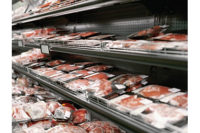
|
| Photo by Vito Palmisano |
bottom line. However, product presentation as well as consumer acceptance are the primary factors that affect final decisions on packaging selection.
Given the dynamic nature of MAP technologies and the demand for improved packaging and better product shelf life, processors must stay on top of MAP trends and be able to help the retailer stay in step with these demands. When dealing with specialty products such as lamb and veal, it is particularly important that case-ready technology offerings assist retailers in a multitude of areas.
According to Joe Dibenedetto, special projects manager for Mountain States Rosen (MSR), “controlling shrink and inventory levels — for margin management as well as offering product variety and consistency in the case — driving return sales and customer satisfaction, are successes that can be directly influenced by MAP technologies.”
Dibenedetto also believes that as technology continues to evolve, retailers will rely more on the manufacturer’s technological expertise and understanding of the retail business in order to help them succeed.
“We have personnel with extensive retail management backgrounds as well as those on the production side of our business,” Dibenedetto explains. “This blend of personnel allows us to effectively link production to retail needs with knowledge of package styling, cutting specifications, product presentation and cost-management strategies.”
Going forward, the survival and growth of small to mid-sized manufacturing companies will likely depend on how they differentiate themselves from their competition. The ability to offer experience, technological knowledge and diversity in product will be essential in the future for specialty-item processors such as Mountain States Rosen.
MSR realizes lamb and veal, while key components of a well-rounded meat program, often make up a smaller percentage of sales. Therefore, MSR must continue to find new ways to support the retailers and distinguish their products from others in the case to ultimately drive sales. Processors must provide insight into technologies and advances that keep retailers on the cutting edge to meet the expectations of their customers. Paul McCauley, director of operations at MSR, considers “sustainable, cost-effective packaging that offers extended shelf-life and reduced waste as the highest priority for the foreseeable future.”
That being said, there are plenty of challenges to these priorities. Defining sustainability is tricky; tying technologies that are continuously evolving to economics and consumer acceptability make for abstract answers. Furthermore, there is a regional twist to packaging technologies, which plays an important part in case-ready packaging offerings and trends.
In similar fashion to most companies with national distribution, MSR has identified differences in packaging preferences between regions and retailers within those regions.
For example, certain geographic regions prefer the overwrap format with the mother-bag that provides a fresh backroom look. These same regions are looking to stay with this technology but make it more sustainable, possibly by adding biodegradable trays, or decreasing total packaging waste.
Another region tends to focus on decreased packaging waste by eliminating the tray, at the same time obtaining extended shelf-life through roll-stock or vacuum-sealed packaging formats.
“Staying abreast of the changes and managing diversification of technology offerings must become a high priority for all manufacturing companies,” says McCauley.
There is no question, as packaging technologies and trends continue to develop and grow, so will the processors in order to keep up with the demands of their customers.




